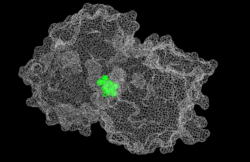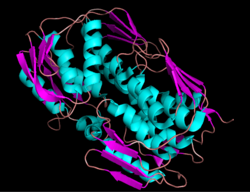Biology:EPSP synthase
| EPSP Synthase (3-phosphoshikimate 1-carboxyvinyltransferase) | |||||||||
|---|---|---|---|---|---|---|---|---|---|
 EPSP synthase liganded with shikimate.[1] | |||||||||
| Identifiers | |||||||||
| EC number | 2.5.1.19 | ||||||||
| CAS number | 9068-73-9 | ||||||||
| Databases | |||||||||
| IntEnz | IntEnz view | ||||||||
| BRENDA | BRENDA entry | ||||||||
| ExPASy | NiceZyme view | ||||||||
| KEGG | KEGG entry | ||||||||
| MetaCyc | metabolic pathway | ||||||||
| PRIAM | profile | ||||||||
| PDB structures | RCSB PDB PDBe PDBsum | ||||||||
| Gene Ontology | AmiGO / QuickGO | ||||||||
| |||||||||
| EPSP synthase (3-phosphoshikimate 1-carboxyvinyltransferase) | |||||||||
|---|---|---|---|---|---|---|---|---|---|
 Ribbon diagram of EPSP synthase | |||||||||
| Identifiers | |||||||||
| Symbol | EPSP_synthase | ||||||||
| Pfam | PF00275 | ||||||||
| InterPro | IPR001986 | ||||||||
| PROSITE | PDOC00097 | ||||||||
| SCOP2 | 1eps / SCOPe / SUPFAM | ||||||||
| |||||||||
5-enolpyruvylshikimate-3-phosphate (EPSP) synthase is an enzyme produced by plants and microorganisms. EPSPS catalyzes the chemical reaction:
- phosphoenolpyruvate (PEP) + 3-phospho shikimate (S3P) ⇌ phosphate + 5-enolpyruvylshikimate-3-phosphate (EPSP)
Thus, the two substrates of this enzyme are phosphoenolpyruvate (PEP) and 3-phosphoshikimate, whereas its two products are phosphate and 5-enolpyruvylshikimate-3-phosphate.
This enzyme is not present in the genomes of animals. It presents an attractive biological target for herbicides, such as glyphosate. A glyphosate-resistant version of this gene has been used in genetically modified crops.
Nomenclature
The enzyme belongs to the family of transferases, to be specific those transferring aryl or alkyl groups other than methyl groups. The systematic name of this enzyme class is phosphoenolpyruvate:3-phosphoshikimate 5-O-(1-carboxyvinyl)-transferase. Other names in common use include:
- 5-enolpyruvylshikimate-3-phosphate synthase,
- 3-enolpyruvylshikimate 5-phosphate synthase,
- 3-enolpyruvylshikimic acid-5-phosphate synthetase,
- 5′-enolpyruvylshikimate-3-phosphate synthase,
- 5-enolpyruvyl-3-phosphoshikimate synthase,
- 5-enolpyruvylshikimate-3-phosphate synthetase,
- 5-enolpyruvylshikimate-3-phosphoric acid synthase,
- enolpyruvylshikimate phosphate synthase, and
- 3-phosphoshikimate 1-carboxyvinyl transferase.
Structure
EPSP synthase is a monomeric enzyme with a molecular mass of about 46,000.[2][3][4] It is composed of two domains, which are joined by protein strands. This strand acts as a hinge, and can bring the two protein domains closer together. When a substrate binds to the enzyme, ligand bonding causes the two parts of the enzyme to clamp down around the substrate in the active site.
EPSP synthase has been divided into two groups according to glyphosate sensitivity. Class I enzyme, contained in plants and in some bacteria, is inhibited at low micromolar glyphosate concentrations, whereas class II enzyme, found in other bacteria, is resistant to inhibition by glyphosate.[5]
Shikimate pathway
EPSP synthase participates in the biosynthesis of the aromatic amino acids phenylalanine, tyrosine, and tryptophan via the shikimate pathway in bacteria, fungi, and plants. EPSP synthase is produced only by plants and micro-organisms; the gene coding for it is not in the mammalian genome.[6][7] Gut flora of some animals contain EPSPS.[8]
Reaction
EPSP synthase catalyzes the reaction which converts shikimate-3-phosphate plus phosphoenolpyruvate to 5-enolpyruvylshikimate-3-phosphate (EPSP) by way of an acetal-like tetrahedral intermediate.[9][10] Basic and amino acids in the active site are involved in deprotonation of the hydroxyl group of PEP and in the proton-exchange steps related to the tetrahedral intermediate itself, respectively.[11]
Studies of the enzyme kinetics for this reaction have determined the specific sequence and energetics of each step of the process.[12] A deprotonated lysine22 acts as a general base, deprotonating the hydroxyl of S3P such that the resulting oxyanion can attack the most electrophilic carbon of PEP. Glutamate341 acts as a general acid by donating a H+. The deprotonated glutamate341 then acts as a base, taking back its proton, and the S3P group is kicked off and protonated by the protonated lysine.
Herbicide target
EPSP synthase is the biological target for the herbicide glyphosate.[13] Glyphosate is a competitive inhibitor of EPSP synthase, acting as a transition state analog that binds more tightly to the EPSPS-S3P complex than PEP and inhibits the shikimate pathway. This binding leads to inhibition of the enzyme's catalysis and shuts down the pathway. Eventually this results in organism death from lack of aromatic amino acids the organism requires to survive.[5][14]
A version of the enzyme that both was resistant to glyphosate and that was still efficient enough to drive adequate plant growth was identified by Monsanto scientists after much trial and error in an Agrobacterium strain called CP4 (Q9R4E4). The strain CP4 was found surviving in a waste-fed column at a glyphosate production facility. The CP4 EPSP synthase enzyme has been engineered into several genetically modified crops.[5][15]
References
- ↑ "Molecular basis for the glyphosate-insensitivity of the reaction of 5-enolpyruvylshikimate 3-phosphate synthase with shikimate". FEBS Lett. 579 (25): 5773–80. October 2005. doi:10.1016/j.febslet.2005.09.066. PMID 16225867.
- ↑ Goldsbrough, Peter (1990). "Gene amplification in glyphosate tolerant tobacco cells". Plant Science 72 (1): 53–62. doi:10.1016/0168-9452(90)90186-r.
- ↑ "Crystallization of 5-enolpyruvylshikimate 3-phosphate synthase from Escherichia coli". Journal of Molecular Biology 186 (3): 673. Dec 1985. doi:10.1016/0022-2836(85)90140-8. PMID 3912512.
- ↑ "Purification and Properties of 5-Enolpyruvylshikimate-3-Phosphate Synthase from Dark-Grown Seedlings of Sorghum bicolor". Plant Physiology 87 (1): 232–8. May 1988. doi:10.1104/pp.87.1.232. PMID 16666109.
- ↑ 5.0 5.1 5.2 "Molecular basis of glyphosate resistance-different approaches through protein engineering". The FEBS Journal 278 (16): 2753–66. Aug 2011. doi:10.1111/j.1742-4658.2011.08214.x. PMID 21668647.
- ↑ "Molecular basis for the herbicide resistance of Roundup Ready crops". Proceedings of the National Academy of Sciences of the United States of America 103 (35): 13010–5. Aug 2006. doi:10.1073/pnas.0603638103. PMID 16916934. Bibcode: 2006PNAS..10313010F.
- ↑ "The shikimate pathway and aromatic amino Acid biosynthesis in plants". Annual Review of Plant Biology 63 (1): 73–105. 2012. doi:10.1146/annurev-arplant-042811-105439. PMID 22554242. "The AAA pathways consist of the shikimate pathway (the prechorismate pathway) and individual postchorismate pathways leading to Trp, Phe, and Tyr.... These pathways are found in bacteria, fungi, plants, and some protists but are absent in animals. Therefore, AAAs and some of their derivatives (vitamins) are essential nutrients in the human diet, although in animals Tyr can be synthesized from Phe by Phe hydroxylase....The absence of the AAA pathways in animals also makes these pathways attractive targets for antimicrobial agents and herbicides.".
- ↑ "The current status and environmental impacts of glyphosate-resistant crops: a review". Journal of Environmental Quality 35 (5): 1633–58. 2006. doi:10.2134/jeq2005.0378. PMID 16899736. https://naldc-legacy.nal.usda.gov/naldc/download.xhtml?id=7373&content=PDF.
- ↑ Comprehensive Natural Products II. Chemistry and Biology.. Reference Module in Chemistry, Molecular Sciences and Chemical Engineering. 8. 2010. pp. 663–688.
- ↑ Anderson, Karen S.; Sammons, R. Douglas; Leo, Gregory C.; Sikorski, James A.; Benesi, Alan J.; Johnson, Kenneth A. (1990). "Observation by carbon-13 NMR of the EPSP synthase tetrahedral intermediate bound to the enzyme active site". Biochemistry 29 (6): 1460–1465. doi:10.1021/bi00458a017. PMID 2334707.
- ↑ Park, HaJeung; Hilsenbeck, Jacqueline L.; Kim, Hak Jun; Shuttleworth, Wendy A.; Park, Yong Ho; Evans, Jeremy N.; Kang, ChulHee (2004). "Structural studies of Streptococcus pneumoniae EPSP synthase in unliganded state, tetrahedral intermediate‐bound state and S3P‐GLP‐bound state". Molecular Microbiology 51 (4): 963–971. doi:10.1046/j.1365-2958.2003.03885.x. PMID 14763973.
- ↑ Anderson, Karen S.; Sikorski, James A.; Johnson, Kenneth A. (1988). "A tetrahedral intermediate in the EPSP synthase reaction observed by rapid quench kinetics". Biochemistry 27 (19): 7395–7406. doi:10.1021/bi00419a034. PMID 3061457.
- ↑ Fonseca, Emily C. M.; da Costa, Kauê S.; Lameira, Jerônimo; Alves, Cláudio Nahum; Lima, Anderson H. (2020). "Investigation of the target-site resistance of EPSP synthase mutants P106T and T102I/P106S against glyphosate" (in en). RSC Advances 10 (72): 44352–44360. doi:10.1039/D0RA09061A. ISSN 2046-2069. PMC 9058485. http://xlink.rsc.org/?DOI=D0RA09061A.
- ↑ "Interaction of the herbicide glyphosate with its target enzyme 5-enolpyruvylshikimate 3-phosphate synthase in atomic detail". Proceedings of the National Academy of Sciences of the United States of America 98 (4): 1376–80. Feb 2001. doi:10.1073/pnas.98.4.1376. PMID 11171958. Bibcode: 2001PNAS...98.1376S.
- ↑ "Herbicide-resistant crops: utilities and limitations for herbicide-resistant weed management". Journal of Agricultural and Food Chemistry 59 (11): 5819–29. Jun 2011. doi:10.1021/jf101286h. PMID 20586458.
Further reading
- "The enzymic synthesis of chorismic and prephenic acids from 3-enolpyruvylshikimic acid 5-phosphate". The Journal of Biological Chemistry 242 (1): 82–90. Jan 1967. doi:10.1016/S0021-9258(18)96321-0. PMID 4289188. http://www.jbc.org/content/242/1/82.long.
 |


